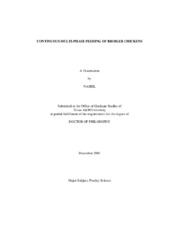| dc.description.abstract | Continuous multi-phase feeding of broiler chickens was evaluated to optimize broiler nutrition and minimize environmental impact related to excess nitrogen in poultry manure. Four experiments were conducted. Experiments 1 and 2 studied effects of continuous multi-phase feeding during a 3-week starting period using battery brooders while experiments 3 and 4 evaluated multi-phase feeding during a traditional 7-week growing period using both battery brooders and floor pens.
In the first and second experiments, the nutrient content of the multi-phase diets was changed every 24 hours in comparison to single-phase feeding. Results indicated that during the starter period, continuous multi-phase feeding had no significant influence on feed consumption, daily gain, feed to gain ratio or fecal nitrogen.
In the third and fourth experiments, a four phase industry type broiler feeding program was compared to intensive multi-phase feeding programs created by linearly blending three different diets based on typical industry nutrient values and a commercial nutrient modeling computer program (EFG Natal®). In both intensive multi-phase feeding programs, the diets were changed every three days over a 7-week growth period. Broilers in experiment 3 were raised in Petersime battery brooders to primarily access nitrogen balance while birds in experiment 4 were raised in a floor pen on pine shaving litter to resemble commercial broiler production. The results indicated that intensive multi-phase feeding improved body weight gain and feed to gain ratio only in weeks 5 and 6 but not during the overall 7-week period. Nitrogen excretion and nitrogen retention were unaffected by the intensive multi-phase feeding systems. Economic analysis indicated that intensive multi-phase feeding programs could potentially lower feed costs per kilogram of gain. However, the high cost of implementing a continuous multi-phase feeding system may not justify the relatively small gain in lower feed cost per kilogram of gain. In conclusion, continuous multi-phase feeding of broiler chickens using corn-soy diets does not appear to be justified by either increased performance or reduced nitrogen excretion. | en |


